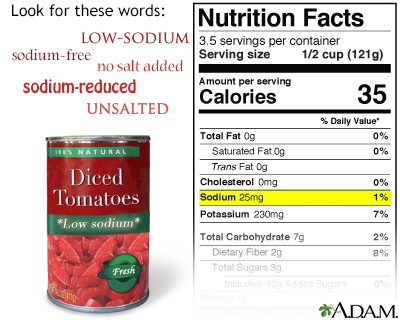Low-salt diet
Low-sodium diet; Salt restriction

If you have high blood pressure or heart, liver, or kidney problems, your health care provider may suggest you lower your sodium intake. Look for these words on labels low-sodium, sodium-free, no salt added, or unsalted. Check all labels to see how many milligrams of sodium there are per serving. Be sure to note how many servings there are in the package. Also, avoid foods that list salt near the top of the list of ingredients. Try to choose foods that have 140 milligrams or less of sodium per serving. A common daily sodium intake goal is 1,500 mg per day. Ask your provider what is best for you.
Salt and Your Diet
Your body needs salt to work properly. Salt contains sodium. Sodium helps your body control many functions. Too much sodium in your diet can be bad for you. For most people, dietary sodium comes from salt that is in or added to their food.
If you have high blood pressure or heart failure, you will likely be asked to limit how much salt you eat every day. Even people with normal blood pressure will have lower (and healthier) blood pressure if they lower how much salt they eat.
Dietary sodium is measured in milligrams (mg). Your health care provider may tell you to eat no more than 2,300 mg a day when you have these conditions. A measuring teaspoon of table salt contains 2,300 mg of sodium. For some people, 1,500 mg a day is an even better goal.
Limiting Salt in Your Diet
Eating a variety of foods every day can help you limit salt. Try to eat a balanced diet.
Buy fresh vegetables and fruits whenever possible. They are naturally low in sodium. Canned foods often contain salt to preserve the color of the food and keep it looking fresh. For this reason, it is better to buy fresh foods. Also buy:
- Fresh meats, chicken or turkey, and fish
- Fresh or frozen vegetables and fruits
Look for these words on labels:
- Low-sodium
- Sodium-free
- No salt added
- Sodium-reduced
- Unsalted
Check all labels for how much salt foods contain per serving.
Ingredients are listed in order of the amount the food contains. Avoid foods that list salt near the top of the list of ingredients. A product with less than 140 mg of sodium per serving is good.
Stay away from foods that are always high in salt. Some common ones are:
- Processed foods, such as cured or smoked meats, bacon, hot dogs, sausage, bologna, ham, and salami
- Anchovies, olives, pickles, and sauerkraut
- Soy and Worcestershire sauces, tomato and other vegetable juices, and most cheeses
- Many bottled salad dressings and salad dressing mixes
- Most snack foods, such as chips, crackers, and others
When you cook, replace salt with other seasonings. Pepper, garlic, herbs, and lemon are good choices. Avoid packaged spice blends. They often contain salt.
Use garlic and onion powder, not garlic and onion salt. Don't eat foods with monosodium glutamate (MSG).
When you go out to eat, stick to steamed, grilled, baked, boiled, and broiled foods with no added salt, sauce, or cheese. If you think the restaurant might use MSG, ask them not to add it to your order.
Use oil and vinegar on salads. Add fresh or dried herbs. Eat fresh fruit or sorbet for dessert, when you have dessert. Take the salt shaker off your table. Replace it with a salt-free seasoning mix.
Ask your provider or pharmacist what antacids and laxatives contain little or no sodium, if you need these medicines. Some have a lot of sodium in them.
Home water softeners add salt to water. If you have one, limit how much tap water you drink. Drink bottled water instead.
Ask your provider if a salt substitute is safe for you. Many contain a lot of potassium. This may be harmful if you have certain medical conditions or if you are taking certain medicines. However, if extra potassium in your diet would not be harmful to you, a salt substitute is a good way to lower the amount of sodium in your diet.
References
Arnett DK, Blumenthal RS, Albert MA, Buroker AB, et al. 2019 ACC/AHA guideline on the primary prevention of cardiovascular disease: a report of the American College of Cardiology/American Heart Association Task Force on Clinical Practice Guidelines. Circulation. 2019;140(11):e596-e646. PMID: 30879355
Bakris GL, Sorrentino MJ. Systemic hypertension: mechanisms, diagnosis, and treatment. In: Libby P, Bonow RO, Mann DL, Tomaselli GF, Bhatt DL, Solomon SD, eds. Braunwald's Heart Disease: A Textbook of Cardiovascular Medicine. 12th ed. Philadelphia, PA: Elsevier; 2022:chap 26.
Hensrud DD. Diet and nutrition. In: Goldman L, Cooney KA, eds. Goldman-Cecil Medicine. 27th ed. Philadelphia, PA: Elsevier; 2024:chap 13.
Rayner B, Charlton KE, Derman W, Jones E. Nonpharmacologic prevention and treatment of hypertension. In: Johnson RJ, Floege J, Tonelli M, eds. Comprehensive Clinical Nephrology. 7th ed. Philadelphia, PA: Elsevier; 2024:chap 36.
US Department of Agriculture and US Department of Health and Human Services. Dietary Guidelines for Americans, 2020-2025. 9th ed.
Version Info
Last reviewed on: 7/24/2024
Reviewed by: Stefania Manetti, RD/N, CDCES, RYT200, My Vita Sana LLC - Nourish and heal through food, San Jose, CA. Review provided by VeriMed Healthcare Network. Also reviewed by David C. Dugdale, MD, Medical Director, Brenda Conaway, Editorial Director, and the A.D.A.M. Editorial team.
